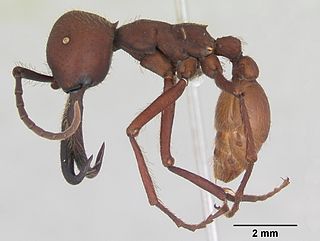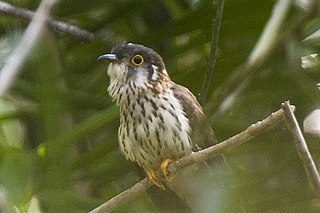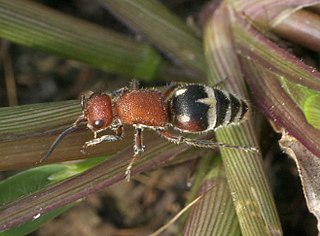
Vågan is a municipality in Nordland county, Norway. It is part of the traditional district of Lofoten. The administrative centre of the municipality is the town of Svolvær. Some of the villages in Vågan include Digermulen, Gimsøysand, Gravermarka, Henningsvær, Hopen, Kabelvåg, Kleppstad, Laupstad, Liland, Skrova, Straumnes, and Sydalen.

Erica vagans, the Cornish heath or wandering heath, is a species of flowering plant in the family Ericaceae, native to Ireland, Cornwall, western France and Spain. It is a vigorous, spreading, evergreen heather reaching 75 cm (30 in) tall and wide, with pink flowers borne in racemes 14 cm (6 in) long in summer and autumn. The Latin specific epithet vagans literally means "wandering"; in this context it means "widely distributed".

Tliltocatl vagans is a species of tarantula known commonly as the Mexican red rump. It ranges predominantly in Mexico, but is also found in Central America. They are terrestrial, burrowing spiders. The reason for the name red rump is because of its distinctive red hairs on its abdomen. Like most tarantulas, they will eat anything they can overpower, which is usually insects, but small lizards and rodents may also be consumed. They can grow up to a solid 6.5 inch leg span, with males typically being smaller and thinner than the females. They prefer shrubland habitats.

Macelognathus is an extinct genus of sphenosuchian crocodylomorph from the Late Jurassic. Originally it was believed be a turtle and later a dinosaur. It lived in what is now Wyoming, in North America.
NVC community H5 is one of the heath communities in the British National Vegetation Classification system. It is one of three communities which are considered transitional between the lowland dry heaths and the wetter communities classified in the NVC as mires.
NVC community H6 is one of the heath communities in the British National Vegetation Classification system. It is one of five communities categorised as lowland dry heaths.

Eciton vagans is a species of New World army ant in the genus Eciton. It occurs in dry and wet forest habitats, occupying a range extending from Mexico to throughout Costa Rica and possibly Panama and Colombia. Raids are always in columns and are distinguished in being usually nocturnal; preferred prey commonly include other ants. It is closely related to the Eciton burchellii species.

The moustached hawk-cuckoo is a species of cuckoo in the family Cuculidae. It is found in Brunei, Indonesia, Laos, Malaysia, Myanmar, and Thailand. Its natural habitat is evergreen and secondary forests. Threatened by habitat loss, it has been assessed as a near-threatened species.
Conacmella vagans is a species of minute, salt marsh snails with an operculum, aquatic gastropod mollusks, or micromollusks, in the family Assimineidae. This species is endemic to Japan.

Dasychira vagans, the variable tussock moth, is a moth of the family Erebidae. It is found in North America, where it has been recorded from Newfoundland to southern British Columbia in the north and North Carolina and Utah in the west. The species was first described by William Barnes and James Halliday McDunnough in 1913.

The half-black bumblebee is a small bumblebee with a wide distribution in North America, its range extending from Ontario to Nova Scotia and southward to Georgia.
Apicystis is a genus of parasitic alveolates of the phylum Apicomplexa.

Epiperipatus brasiliensis is a species of velvet worm in the Peripatidae family. Males of this species have 29 pairs of legs; females have 31 or 33. This species ranges from 37 mm to 80 mm in length. The type locality is in Pará, Brazil. Epiperipatus vagans from Barro Colorado Island (Panama) was originally described as subspecies of Epiperipatus brasiliensis, but is now treated as a full species.
Epiperipatus vagans is a species of velvet worm in the Peripatidae family. The male of this species has 29 or 30 pairs of legs; females have 32 or 33. The type locality is in Panama.

Timulla is a genus of velvet ants in the family Mutillidae. There are almost 200 described species in Timulla.

Aristida vagans, the threeawn speargrass, is a species of grass native to Australia. Found in dry eucalyptus woodland or forest, it may reach 80 cm (30 in) tall. The specific epithet vagans is from Latin, meaning "wanderer". The plant was first collected by botanists in Sydney, and published in 1799 by the Spanish taxonomist Antonio José Cavanilles.

Timula dubitata is a species of velvet ant of the family Mutillidae. It belongs to the Timulla genus.
Timulla atriceps is a species of velvet ant of the genus Timulla. It occurs in South America, in the north of Brazil.

Timula ferrugata is a species of velvet ant, of the Timulla genus, the species lives in the southeastern United States. The species has an orange color on almost all of its body, the beak and rear are brown and dark orange.













